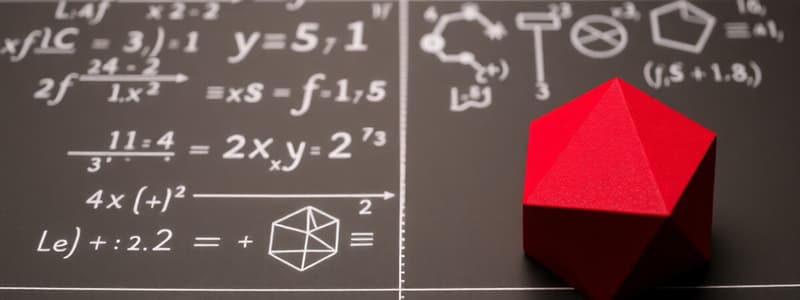Podcast
Questions and Answers
What is an example of a basic operation in arithmetic?
What is an example of a basic operation in arithmetic?
- Integration
- Subtraction (correct)
- Factorization
- Graphing
Which of the following is true regarding algebra?
Which of the following is true regarding algebra?
- It focuses solely on geometry.
- It excludes functions.
- It only involves numbers.
- It uses letters to represent numbers. (correct)
What is the Pythagorean theorem used for in geometry?
What is the Pythagorean theorem used for in geometry?
- Determining the lengths of sides in a right triangle (correct)
- Calculating the volume of a cube
- Finding the area of a circle
- Identifying prime numbers
Which trigonometric function relates the opposite side of a right triangle to its hypotenuse?
Which trigonometric function relates the opposite side of a right triangle to its hypotenuse?
In calculus, what does a derivative represent?
In calculus, what does a derivative represent?
Which of the following is a method of data collection in statistics?
Which of the following is a method of data collection in statistics?
In probability, what is the sum of the probabilities of all possible outcomes?
In probability, what is the sum of the probabilities of all possible outcomes?
What term describes the study of countable, distinct structures in mathematics?
What term describes the study of countable, distinct structures in mathematics?
Flashcards are hidden until you start studying
Study Notes
Key Areas of Mathematics
-
Arithmetic
- Basic operations: addition, subtraction, multiplication, division.
- Number properties: prime numbers, even/odd, integers, fractions, decimals.
-
Algebra
- Variables and constants: use of letters to represent numbers.
- Expressions and equations: solving for unknowns.
- Functions: relationships between variables; concepts of domain and range.
-
Geometry
- Shapes and properties: triangles, quadrilaterals, circles, polygons.
- Theorems: Pythagorean theorem, properties of angles and lines.
- Measurement: area, perimeter, volume.
-
Trigonometry
- Functions: sine, cosine, tangent.
- Relationships in right triangles.
- Unit circle and applications in angles.
-
Calculus
- Limits: fundamental concept for derivatives and integrals.
- Derivatives: rate of change, slopes of curves.
- Integrals: area under curves, accumulation of quantities.
-
Statistics
- Data collection methods: surveys, experiments, observational studies.
- Descriptive statistics: mean, median, mode, range.
- Inferential statistics: hypothesis testing, confidence intervals.
-
Probability
- Basic concepts: experiments, outcomes, events.
- Rules: addition and multiplication rules.
- Distributions: normal, binomial, Poisson.
-
Discrete Mathematics
- Study of countable, distinct structures.
- Topics: graph theory, combinatorics, logic.
-
Mathematical Reasoning
- Inductive vs. deductive reasoning.
- Use of proofs: direct, indirect, contradiction.
Applications of Mathematics
- Science and Engineering: Quantitative analysis, modeling, problem-solving.
- Finance: Calculating interest, investment analysis, risk assessment.
- Computer Science: Algorithms, data structures, cryptography.
Important Concepts
- Order of Operations: PEMDAS (Parentheses, Exponents, Multiplication and Division, Addition and Subtraction).
- Mathematical Notation: Understanding symbols and terms (e.g., Σ for summation, ∫ for integrals).
- Graphing: Plotting functions on Cartesian coordinates; understanding slopes and intercepts.
Key Areas of Mathematics
-
Arithmetic
- Involves basic operations: addition, subtraction, multiplication, and division.
- Includes properties of numbers such as prime numbers, and classifications like even/odd, integers, fractions, and decimals.
-
Algebra
- Utilizes variables (letters) to represent unknown numbers.
- Focuses on solving expressions and equations to find unknown values.
- Functions depict relationships between variables, incorporating concepts of domain (inputs) and range (outputs).
-
Geometry
- Studies various shapes, including triangles, quadrilaterals, circles, and polygons, along with their properties.
- Incorporates important theorems like the Pythagorean theorem, exploring properties of angles and lines.
- Measurement techniques involve calculating area, perimeter, and volume of geometric figures.
-
Trigonometry
- Defined by functions such as sine, cosine, and tangent.
- Explores the relationships within right triangles to solve for unknown sides and angles.
- The unit circle serves as a critical tool for understanding angle measures and trigonometric functions.
-
Calculus
- The concept of limits is foundational for understanding derivatives and integrals.
- Derivatives denote the rate of change and describe the slopes of curves at specific points.
- Integrals represent the total accumulation, calculating the area under curves.
-
Statistics
- Various methods for data collection include surveys, experiments, and observational studies.
- Descriptive statistics summarize data using measures like mean, median, mode, and range.
- Inferential statistics enable hypothesis testing and generating confidence intervals from sample data.
-
Probability
- Essential concepts include experiments, outcomes, and events as fundamental building blocks.
- Incorporates addition and multiplication rules for calculating probabilities of combined events.
- Probability distributions like normal, binomial, and Poisson help analyze different data sets.
-
Discrete Mathematics
- Focuses on countable and distinct structures, crucial for theoretical computer science.
- Includes specific topics such as graph theory, combinatorics, and logical reasoning.
-
Mathematical Reasoning
- Differentiates between inductive reasoning (generalizations based on patterns) and deductive reasoning (logical conclusions based on premises).
- Involves various proof strategies, including direct, indirect, and proof by contradiction.
Applications of Mathematics
-
Science and Engineering
- Mathematics supports quantitative analysis, creates models for real-world problems, and aids in troubleshooting technical issues.
-
Finance
- Essential for calculating interest, analyzing investment strategies, and assessing financial risks.
-
Computer Science
- Mathematics is foundational for developing algorithms, designing data structures, and ensuring data security through cryptography.
Important Concepts
-
Order of Operations
- The PEMDAS rule dictates the sequence for evaluating expressions: Parentheses, Exponents, Multiplication and Division, Addition and Subtraction.
-
Mathematical Notation
- Familiarity with symbols is vital, such as Σ for summation and ∫ for integrals, enabling clear communication of mathematical ideas.
-
Graphing
- Plotting functions on Cartesian coordinates helps visualize relationships between variables, focusing on slopes and y-intercepts for deeper analysis.
Studying That Suits You
Use AI to generate personalized quizzes and flashcards to suit your learning preferences.




